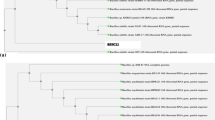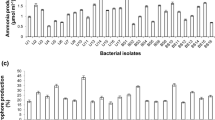Abstract
A Gram-positive rod-shaped bacterium isolated on nutrient agar plates incubated at 28 ± 2°C. The identity of the bacterium was confirmed by sequencing of the 16S rRNA gene and it reveals that it shares highest similarity with Bacillus thioparus CECT 7196T (99.08%). It was capable of growing at temperatures ranging from 4 to 40°C, but optimum growth was observed at 28 ± 2°C. Strain NII-0902 is endowed with multiple plant growth promotion attributes such as phosphate solubilization, Indole acetic acid (IAA), siderophore and HCN production, which were expressed differentially at sub-optimal temperatures (5–40°C). It was able to solubilize phosphate (17.7 μg ml−1), and produce IAA (139.7 μg ml−1) at 28 ± 2°C. Qualitative detection of siderophore production and HCN were also observed. At 5°C it was found to express all the plant growth promotion attributes except HCN production. The ability to colonize roots is a sine qua non condition for a rhizobacteria to be considered a true plant growth-promoting rhizobacteria (PGPR). Bacillus sp. NII-0902 has a potential ability to colonize roots visualized by transparency, bacterial growth (turbid, milky and narrow zone) along and around roots and truly supported by scanning electron micrograph. Hence, it is proposed that, Bacillus thioparus sp. NII-0902 could be deployed as an inoculant to attain the desired results of bacterization.




Similar content being viewed by others
References
Ahmad F, Ahmad I, Khan MS (2008) Screening of free-living rhizospheric bacteria for their multiple plant growth-promoting activities. Microbiol Res 163:173–181
Altschul SF, Gish W, Miller W, Myers EW, Lipman DJ (1990) Basic local alignment search tool. J Mol Biol 215:403–410
Andrews JH, Harris RF (2000) The ecology and biogeography of microorganisms on plant surfaces. Annu Rev Phytopathal 38:145–180
Bakker AW, Schipper B (1987) Microbial cyanide production in the rhizosphere in relation to potato yield reduction and Pseudomonas spp. mediated plant growth stimulation. Soil Biol Biochem 19:451–457
Baudoin E, Lerner A, Sajjad Mirza M, El Zemrany H, Prigent-Combaret C, Jurkevich E, Spaepen S, Vanderleyden J, Nazaret S, Okon Y, Moënne-Loccoz Y (2010) Effects of Azospirillum brasilense with genetically-modified auxin biosynthesis gene ipdC on the diversity of the indigenous microbiota of the wheat rhizosphere. Res Microbiol (in Press)
Biari A, Gholami A, Rahmani HA (2008) Growth promotion and enhanced nutrient uptake of maize (Zea mays L.) by application of plant growth promoting rhizobacteria in Arid region of Iran. J Boil Sci 8:1015–1020
Cui XL, Mao PH, Zeng M, Li WJ, Zhang LP, Xu LH, Jiang CL (2001) Streptomonospora salina gen. nov., sp. nov., a new member of the family Nocardiopsaceae. Int J Syst Evol Microbiol 51:357–363
Del Campillo SE, Van der Zee SEATM, Torrent J (1999) Modelling long-term phosphorous leaching and changes in phosphorous fertility in selectively fertilized acid sandy soils. Eur J Soil Sci 50:391–399
Felsenstein J (1985) Confidence limits on phylogenies: an approach using the bootstrap. Evolution 39:783–791
Glick BR (1995) The enhancement of plant growth by free-living bacteria. Can J Microbiol 41:109–117
Gordon AS, Weber RP (1951) Colorimetric estimation of indole acetic acid. Plant Physiol 26:192–195
Jaspers E, Overmann J (2004) Ecological Significance of Microdiversity: Identical 16S rRNA Gene Sequences Can Be Found in Bacteria with Highly Divergent Genomes and Ecophysiologies. App Environ Microbiol 70(8):4831–4839
Jones DL, Darrah PR (1994) Role of root derived organic acids in the mobilization of nutrients from the rhizosphere. Plant Soil 166:247–257
Jukes TH, Cantor CR (1969) Evolution of protein molecules. In: Munro HN (ed) Mammalian Protein Metabolism, vol 3. Academic Press, New York, pp 21–132
Khalid A, Arshad M, Zahir ZA (2004) Screening plant growth promoting rhizobacteria for improving growth and yield of wheat. J Appl Microbiol 96:473
Martínez-Murcia A, Benlloch S, Collins D (1992) Phylogenetic interrelationships of members of the genera Aeromonas and Plesiomonas as determined by 16 s ribosomal DNA sequencing: lack of congruence with results of DNA-DNA hybridizations. Int J Syst Bacteriol 42:412–421
Mónica Pérez-Ibarra B, Flores ME, Varela MG (2007) Isolation and characterization of Bacillus thioparus sp. nov., chemolithoautotrophic, thiosulfate-oxidizing bacterium. FEMS Microbiol Lett 271:289–296
Nautiyal CS (1999) An efficient microbiological growth medium for screening phosphate-solubilizing microorganisms. FEMS Microbiol Lett 170:265–270
Palys T, Berger E, Mitrica I, Nakamura LK, Cohan FM (2000) Protein-coding genes as molecular markers for ecologically distinct populations: the case of two Bacillus species. Int J Syst Evol Microbiol 50(3):1021–1028
Pankaj T, Anita P, Tongmin S (2007) Chromate reducing and plant growth promoting activies of psychrotrophic Rhodococcus erythropolis MtCC 7905. J Basic Microbiol 47:513–517
Pikovskaya RI (1948) Mobilization of phosphorus in soil connection with the vital activity of some microbial species. Mikrobiologiya 17:362–370
Saitou N, Nei M (1987) The neighbor-joining method: a new method for reconstructing phylogenetic trees. Mol Biol Evol 4:406–425
Schwyn B, Neilands JB (1987) Universal chemical assay for the detection and determination of siderophore. Anal Biochem 160:47–56
Selvakumar G, Kundu S, Joshi P, Nazim S, Gupta AD, Mishra PK, Gupta HS (2008a) Characterization of a cold-tolerant plant growthpromoting bacterium Pantoea dispersa 1A isolated from a sub-alpine soil in the North Western Indian Himalayas. World J Microbiol Biotechnol 24:955–960
Selvakumar G, Mohan M, Kundu S, Gupta AD, Joshi P, Nazim S, Gupta HS (2008b) Cold tolerance and plant growth promotion potential of Serratia marcescens strain SRM (MTCC 8708) isolated from flowers of summer squash (Cucurbita pepo). Lett Appl Microbiol 46:171–175
Selvakumar G, Joshi P, Nazim S, Mishra PK, Bisht JK, Gupta HS (2009) Phosphate solubilization and growth promotion by Pseudomonas fragi CS11RH1 (MTCC 8984) a psychrotolerant bacterium isolated from a high altitude Himalayan rhizosphere. Biologia 64:239–245
Silva HSA, Reginaldo da Silva R, Mounteer A (2003) Development of a Root Colonization Bioassay for rapid screening of rhizobacteria for potential biocontrol agents. J Phytopathol 151:42–46
Thompson JD, Gibson TJ, Plewniak F, Jeanmougin F, Higgins DG (1997) The CLUSTAL_X windows interface: flexible strategies for multiple sequence alignment aided by quality analysis tools. Nucleic Acids Res 25:4876–4882
Vassilev N, Vassileva M (2003) Biotechnological solubilization of rock phosphate on media containing agro-industrial wastes. Appl Microbiol Biotechnol 61:435–440
Whitelaw MA (2000) Growth promotion of plants inoculated with phosphate solubilizing fungi. Adv Agron 69:99–151
Yamamura S, Yamashita M, Fujimoto N, Kuroda M, Kashiwa M, Sei K, Fujita M, Ike Michihiko (2007) Bacillus selenatarsenatis sp. nov., a selenate- and arsenate-reducing bacterium isolated from the effluent drain of a glass-manufacturing plant. Int J Syst Evol Microbiol 57:1060–1064
Acknowledgments
The authors would like to thank CSIR Task force network programme on Exploration of India’s Rich Microbial Diversity (NWP 0006) for providing the financial support.
Author information
Authors and Affiliations
Corresponding authors
Additional information
C. K. Deepa and Syed G. Dastager contributed equally to the work.
Rights and permissions
About this article
Cite this article
Deepa, C.K., Dastager, S.G. & Pandey, A. Plant growth-promoting activity in newly isolated Bacillus thioparus (NII-0902) from Western ghat forest, India. World J Microbiol Biotechnol 26, 2277–2283 (2010). https://doi.org/10.1007/s11274-010-0418-3
Received:
Accepted:
Published:
Issue Date:
DOI: https://doi.org/10.1007/s11274-010-0418-3




